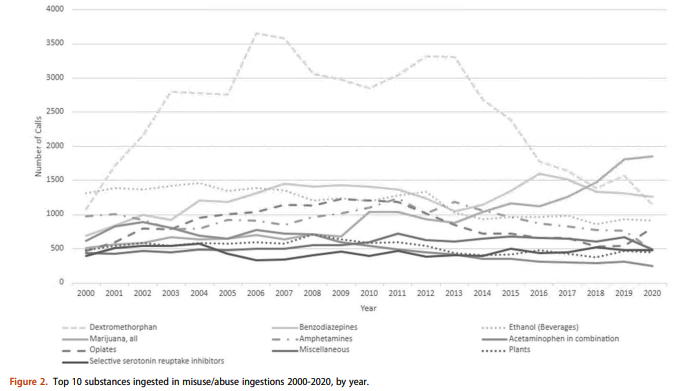From 2000 to 2020, over 330,000 reports were made to the National Poison Data System on intentional substance misuse and abuse exposures for kids ages 6 to 18. An analysis of the outcomes and trends of these exposures were published in Clinical Toxicology with the following trends worth noting:
- Majority of these misuse/abuse cases occurred in males and over 80% in teens ages 13 to 18.
- In 2000, the greatest number of cases involved ethanol (alcohol).
- Between 2001 and 2016, the most reported exposure involved dextromethorphan (known as DXM and is a cough suppressant found in over-the-counter cold and cough medicines).
- Since 2018, the most reported exposure involved marijuana.
- The greatest number of cases overall involved dextromethorphan followed by benzodiazepines.
- Cases of misuse/abuse of marijuana rose 245% whereas ethanol cases gradually declined over this twenty-year period. Marijuana cases exceeded ethanol cases every year since 2014 by a larger amount each year compared to the previous year.
- The highest average monthly increase in exposure rates overall was for marijuana followed by CBD, diphenhydramine-alone (antihistamine used to treat allergies and found in medicines like Benadryl), e-cigarettes containing nicotine, and benzodiazepines.
- For marijuana product exposures, edibles had the largest increase in the average monthly reports of misuse/abuse overall.
The study also analyzed the clinical outcomes of these exposures and found:
- 32.6% had worse than minor outcomes.
- Older age youth experienced more severe clinical outcomes than younger children.
- Males experienced more major or life threatening outcomes.
- While overall deaths were rare, 450 children died with the majority occurring among youth ages 16 to 18 and three occurring in children ages 6 to 9.
- The substances associated with the largest instances of death were: opioids (286), stimulants (141), benzodiazepines (69), marijuana (66), ethanol (54), and antidepressants (19).
- 331,993 children were treated at a health care facility with 30,936 admitted to a critical care unit and 16,973 admitted to a psychiatric facility. The majority were at least 13 years old (34.57% were between ages 13-15 and 48.34% were between ages 16-18).
The trends observed in this research relating to the declining alcohol cases and rising marijuana and vaping cases align with self-reporting data captured in national surveys such as Monitoring the Future and reflects how public health efforts and policy impacts youth use. As the authors highlight, the increasing trend in cases of misuse/abuse involving marijuana is likely attributed to the marijuana legalization movement which has led to a decreased perception of harm and increased access and availability. Also, the declining trend observed for dextromethorphan involved cases is likely attributed to many states banning the sale of such products to minors.
Reference: Adrienne R. Hughes, Sara Grusing, Amber Lin, Robert G. Hendrickson, David C. Sheridan, Rebecca Marshall & B. Zane Horowitz (2022) Trends in intentional abuse and misuse ingestions in school-aged children and adolescents reported to US poison centers from 2000-2020, Clinical Toxicology, DOI: 10.1080/15563650.2022.2120818






